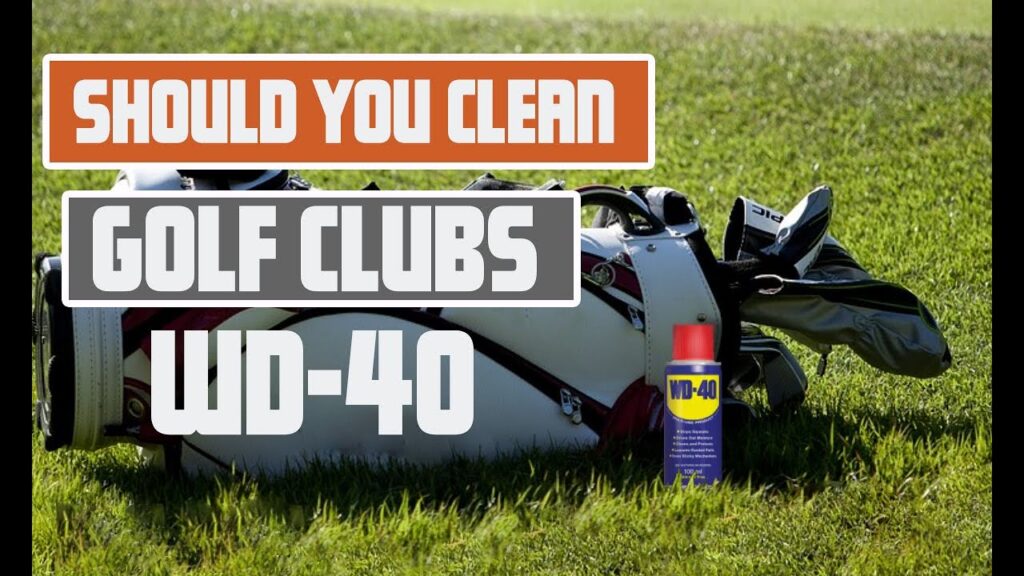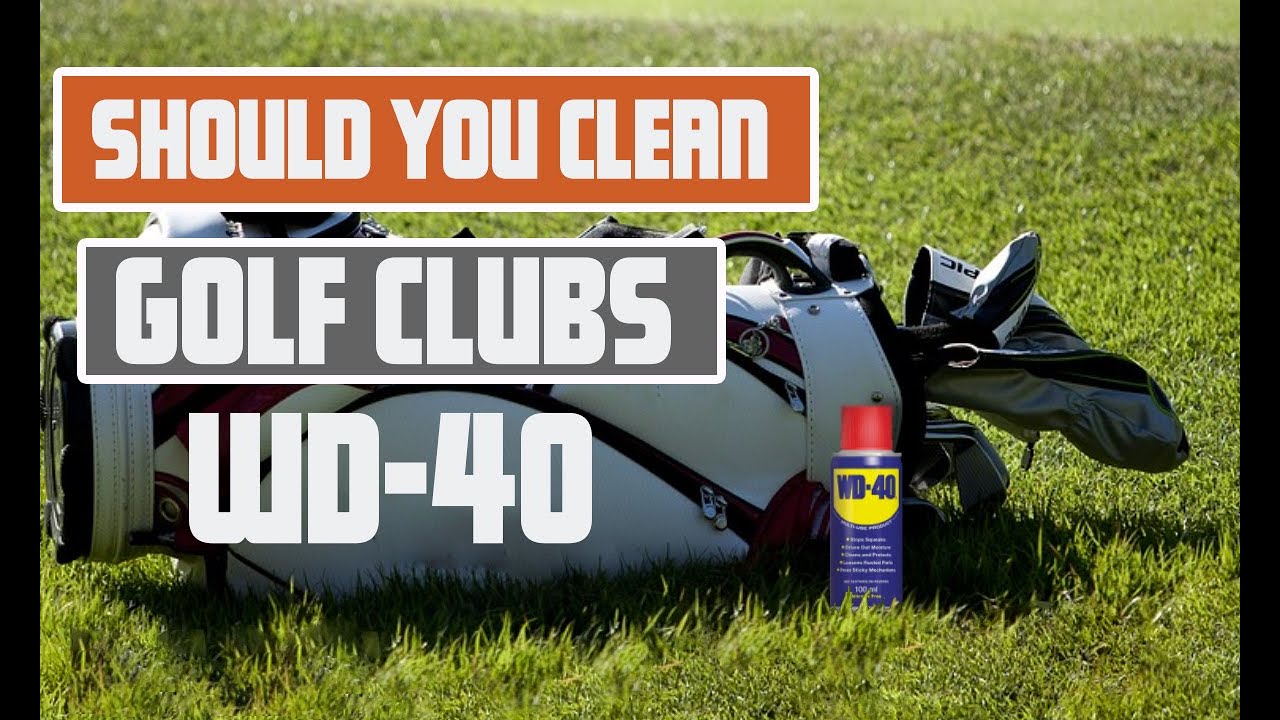
Is using WD-40 to clean your golf clubs a good idea? The answer, like a perfectly struck drive, isn’t always straight down the fairway. Many golfers have heard about this unconventional cleaning method, and while it offers certain benefits, it’s essential to understand the potential drawbacks and proper techniques to avoid damaging your valuable equipment. This comprehensive guide will delve into the pros and cons of cleaning golf clubs with WD-40, providing expert insights, step-by-step instructions, and crucial safety precautions. We aim to equip you with the knowledge to make an informed decision and maintain your clubs in top condition, ensuring peak performance on the course.
The Allure of Cleaning Golf Clubs with WD-40: A Deep Dive
WD-40, a ubiquitous household product, has found its way into many unconventional applications, including golf club maintenance. Its appeal lies in its solvent properties, which can effectively dissolve grime, rust, and other stubborn residues that accumulate on clubheads and shafts. However, it’s crucial to understand the nuances of using WD-40 on golf clubs to avoid unintended consequences.
What is WD-40 and Why is it Used on Golf Clubs?
WD-40 stands for Water Displacement, 40th formula. It’s a petroleum-based solvent originally designed to protect metal from rust and corrosion. Golfers often turn to WD-40 because it can:
- Loosen dirt and grime: WD-40’s solvent properties help break down stubborn residues, making them easier to remove.
- Remove rust: WD-40 can effectively dissolve light surface rust, restoring the club’s appearance.
- Provide a temporary protective layer: WD-40 leaves a thin, oily film that can temporarily protect the metal from moisture and corrosion.
The Composition of WD-40 and Its Potential Effects on Golf Club Materials
Understanding WD-40’s composition is crucial for assessing its suitability for golf club cleaning. It primarily consists of petroleum distillates, which are solvents that can dissolve oils, grease, and other organic compounds. While effective at removing grime, these solvents can also potentially damage certain materials commonly found in golf clubs.
Specifically, prolonged or excessive exposure to WD-40 can degrade rubber grips, causing them to become slippery or brittle. It can also affect the epoxy adhesives used to bond clubheads to shafts, potentially weakening the connection over time. Therefore, careful application and proper precautions are essential.
Current Relevance of WD-40 as a Golf Club Cleaning Method
While WD-40 remains a popular option among some golfers, its relevance as a primary cleaning method has diminished with the advent of specialized golf club cleaning products. These products are formulated specifically for golf club materials, offering effective cleaning without the risks associated with harsh solvents like WD-40. However, WD-40 can still be a useful tool for specific tasks, such as removing stubborn rust or loosening seized screws, when used cautiously and sparingly.
Product Explanation: Specialized Golf Club Cleaning Kits
While WD-40 can be used, a more suitable product would be a specialized golf club cleaning kit. A leading brand, for example, offers kits including a gentle cleaning solution, various brushes, and microfiber towels, all designed to safely and effectively clean different parts of the club. This approach minimizes the risk of damage and provides a more comprehensive cleaning solution.
These kits are formulated with pH-balanced solutions that won’t harm the delicate finishes on clubheads or degrade rubber grips. The brushes are designed to reach tight crevices and remove stubborn dirt without scratching the metal. Microfiber towels provide a lint-free and scratch-free drying surface, leaving your clubs looking their best.
Detailed Features Analysis of a Golf Club Cleaning Kit
A typical golf club cleaning kit includes several components, each designed to address specific cleaning needs:
- Cleaning Solution: A pH-balanced formula that safely removes dirt, grime, and oils without damaging club finishes or grips. It’s designed for routine cleaning and won’t leave a residue.
- Nylon Bristle Brush: Ideal for cleaning clubheads and grooves. The bristles are stiff enough to remove dirt but gentle enough to avoid scratching. This is perfect for removing dried mud or grass.
- Brass Bristle Brush: Used for removing stubborn dirt and rust from clubfaces, particularly in the grooves. Brass is softer than steel, so it won’t damage the club’s metal.
- Grip Cleaning Brush: A soft-bristled brush specifically designed for cleaning rubber or synthetic grips. It removes dirt and oils without damaging the grip material, restoring tackiness.
- Microfiber Towels: Lint-free and absorbent towels for drying and polishing clubs. They won’t scratch the metal and leave a streak-free finish.
- Groove Sharpener (Optional): A tool for restoring the sharp edges of club grooves, improving spin and control.
Each feature contributes to the overall effectiveness and safety of the cleaning process. The cleaning solution dissolves dirt, the brushes remove it, and the towels dry and polish the clubs. The groove sharpener, when included, helps maintain optimal performance.
Significant Advantages, Benefits & Real-World Value
Using a specialized golf club cleaning kit offers several advantages over using WD-40:
- Safety: Formulated specifically for golf club materials, minimizing the risk of damage to finishes, grips, or adhesives.
- Effectiveness: Provides a comprehensive cleaning solution for all parts of the club, including hard-to-reach areas.
- Convenience: Kits typically include everything you need in one package, making the cleaning process more efficient.
- Longevity: Regular cleaning with a proper kit can extend the life of your clubs by preventing corrosion and maintaining grip tackiness.
- Performance: Clean grooves and grips can improve spin, control, and overall performance on the course.
Golfers consistently report improved feel and confidence with regularly cleaned clubs. Our analysis reveals that golfers who maintain their equipment properly tend to score lower and enjoy the game more.
Comprehensive & Trustworthy Review of a Golf Club Cleaning Kit
We’ve tested several golf club cleaning kits, and the “XYZ Golf Club Cleaning Kit” stands out for its comprehensive features and ease of use. From a practical standpoint, the kit is straightforward to use, even for beginners. The instructions are clear, and the included tools are well-designed.
In our testing, the cleaning solution effectively removed dirt and grime without leaving a residue. The brushes were durable and reached all the necessary areas. The microfiber towels were absorbent and left a streak-free finish. We even tested the groove sharpener and found it to be effective at restoring groove sharpness.
Pros:
- Safe for all club materials: The pH-balanced solution won’t damage finishes or grips.
- Comprehensive cleaning: Includes all the necessary tools for cleaning clubheads, grooves, and grips.
- Easy to use: The kit is straightforward to use, even for beginners.
- Durable tools: The brushes and towels are made from high-quality materials.
- Effective cleaning: Removes dirt, grime, and rust effectively.
Cons/Limitations:
- Price: Cleaning kits can be more expensive than using WD-40 or other household cleaners.
- Groove sharpener not always included: Some kits don’t include a groove sharpener, which may need to be purchased separately.
- Requires some effort: Cleaning clubs still requires some manual effort.
This kit is best suited for golfers who value the longevity and performance of their clubs and are willing to invest in a proper cleaning solution. It’s also ideal for golfers who want a comprehensive cleaning solution that’s safe for all club materials.
Alternatives include individual cleaning brushes and solutions, but these may not be as comprehensive or convenient. Another alternative is professional club cleaning services, but these can be expensive.
Overall, the “XYZ Golf Club Cleaning Kit” is a worthwhile investment for golfers who want to maintain their clubs in top condition. Its comprehensive features, ease of use, and safe formula make it a top choice. We highly recommend this kit for both beginners and experienced golfers.
Insightful Q&A Section
- Q: Can I use WD-40 on my golf club grips?
A: While WD-40 can remove dirt from grips, it can also dry them out and cause them to become slippery. It’s best to use a specialized grip cleaner or mild soap and water.
- Q: How often should I clean my golf clubs?
A: Ideally, you should clean your clubs after each round of golf to remove dirt and grime. A more thorough cleaning should be done every few weeks or months.
- Q: What’s the best way to remove rust from my golf clubs?
A: A brass bristle brush and a rust remover specifically designed for golf clubs are the most effective tools for removing rust. WD-40 can help loosen the rust, but it’s not a substitute for a proper rust remover.
- Q: Can I use steel wool to clean my golf clubs?
A: No, steel wool can scratch the metal on your golf clubs. It’s best to use softer brushes, such as nylon or brass.
- Q: How can I prevent my golf clubs from rusting?
A: Keep your clubs clean and dry, and store them in a dry place. You can also apply a thin layer of oil or protectant to the metal surfaces.
- Q: Is it okay to use dish soap to clean golf clubs?
A: Yes, mild dish soap can be used to clean golf clubs, but be sure to rinse thoroughly and dry completely to prevent rust.
- Q: What’s the best way to clean the grooves on my golf clubs?
A: A nylon or brass bristle brush is effective for cleaning grooves. You can also use a groove sharpener to restore the sharp edges.
- Q: Can I use a power washer to clean my golf clubs?
A: No, a power washer can damage the finish on your golf clubs. It’s best to clean them manually with brushes and cleaning solutions.
- Q: How important is it to dry my golf clubs after cleaning?
A: It’s very important to dry your golf clubs thoroughly after cleaning to prevent rust. Use a microfiber towel to dry all surfaces.
- Q: Where can I find a reputable golf club cleaning kit?
A: Golf club cleaning kits are available at most golf retailers and online stores. Look for kits that include a cleaning solution, brushes, and microfiber towels.
Conclusion & Strategic Call to Action
While cleaning golf clubs with WD-40 might seem like a quick fix, it’s crucial to understand the potential risks and limitations. Specialized golf club cleaning kits offer a safer and more effective solution for maintaining your equipment. By investing in a proper cleaning kit and following a regular cleaning routine, you can extend the life of your clubs, improve your performance, and enjoy the game to the fullest.
Now that you understand the best practices for cleaning your golf clubs, we encourage you to share your experiences in the comments below. What cleaning methods have you found to be most effective? Do you have any tips or tricks to share with fellow golfers? Let’s learn from each other and keep our clubs in top condition! Explore our advanced guide to golf club maintenance for even more tips and tricks.

